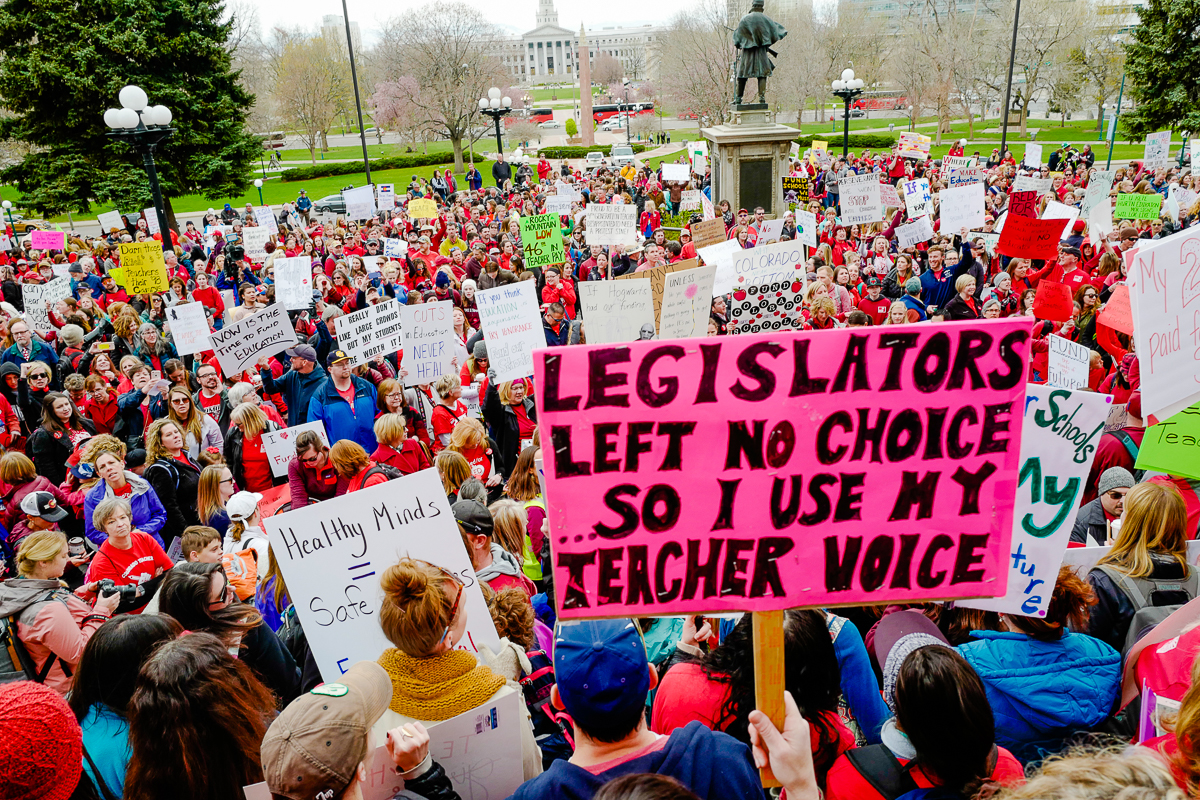The Local newsletter is your free, daily guide to life in Colorado. For locals, by locals.
Jefferson County high school teacher Rhiannon Wenning is taking an unpaid day on Thursday, April 26, to advocate for education funding at the Colorado State Capitol. After years of budget cuts and pay freezes, “I’m actually making less money now with two master’s degrees and 17 years of experience than I was as a first-year teacher,” she says, adding that she works a second job as an Uber driver. While many teachers are using personal leave days for the walkout, Wenning doesn’t have any PTO left for the year, and will need to carefully budget around today’s lost wages. Still, Wenning says it’s worth the financial hit to stand up for her students. “I want to ensure that they have the schools that they deserve and the resources and the educators that they need to be successful,” she says.
Thousands of Colorado teachers are attending organized rallies at the Gold Dome on Thursday and Friday, prompting the state’s 10 largest school districts, serving more than 500,000 students, to release students early or cancel school. The Colorado rallies are riding a national wave of teacher strikes in red states like West Virginia, Oklahoma, Kentucky, and Arizona, as public sector employees across the country are increasingly pushed out of the middle class. In purple Colorado, educators see the national actions as a tipping point—and a teachable moment for voters, lawmakers, and candidates to understand how education cuts are eroding public schools.

According to a 2018 study by U.S. News & World Report (based on data from 2013–16) Colorado has the nation’s best economy—but our state’s public schools don’t appear to be sharing the wealth. After cutting K-12 education funding during the Great Recession, Colorado now underfunds schools by $822 million per year. Meanwhile, the Centennial State ranks last in the nation for teacher wage competitiveness and 40th in per student spending, according to Great Education Colorado. Teachers’ retirement savings may also take a hit under a state bill to reform the Public Employees’ Retirement Association (PERA), which has about $32 billion in unfunded debt.
Thanks in part to Colorado’s Taxpayer Bill of Rights, a unique tax law that limits how much revenue can be raised each year and requires voter approval for tax hikes, our public school system faces a difficult road to restore that funding. Next year’s state budget would make a $150 million payment on the education debt and increase per-student spending by 6 percent—the largest K-12 investment since 2008.
But teachers want a long-term commitment to restore education funding, and are seizing the opportunity to rally voter support for Initiative 93, a proposed ballot measure to generate $1.6 billion annually for schools. “We’re not going to stop until we see adequate funding from the state, especially when Colorado has been so successful economically,” Wenning says. “We have reached a boiling point.”
In their own words, here’s what teachers want you to know about why they’re skipping class:
1) “The class sizes are massive.”
Jessica Popper, a middle school creative writing teacher in Denver Public Schools (DPS), teaches about 260 students in classes of 35. “It’s really difficult to give them equal feedback when you’re checking that many boxes each day,” she says. Popper’s creative writing class was recently cut, along with the school’s cooking, dance, film, and robotics programs. “The electives are just dwindling,” she says. Other cost-cutting measures across the state include four-day school weeks and higher student fees.
2) “There’s no construction paper.”
Thanks to new budget cuts, “We actually are running out of basic supplies,” says Rachel Barnes, an ESL teacher in DPS. Elsewhere, Palmer Hoegh, a high school math teacher in Douglas County School District, had to launch a GoFundMe to raise money for whiteboards. “Most of the contributions came from my own family and friends,” she says. One study shows that Colorado teachers spend an average $656 a year out-of-pocket for school supplies.
3) “We have buildings that are very cold, very hot, or very leaky.”
Facilities are a major issue across the metro area and the state, says Erin Murphy, a high school history teacher in Jeffco Public Schools. Murphy says her school typically sets up at least 60 trash cans to catch leaks if there is a big rainstorm. Worse: Asbestos sometimes flakes off during leaks, causing classroom evacuations. “A student can be successful in that environment, but it’s certainly a distraction,” she says.
4) “We see more and more depression and anxiety.”
Angela Anderson, a high school social studies teacher in Jeffco, says special education and mental health services are especially hard hit by education cuts. In her school of 1,600 students, Anderson says there are only 1.5 mental health professionals. “The biggest thing that I see lacking in our school is support for the kids,” she says. “We’re just seeing more need and there’s no money to support that.”
5) “Teachers in Denver Public Schools can’t even live in Denver.”
Sidelined from Colorado’s fast-growing economy, many teachers can no longer live in the school districts where they work, says Popper. “Some studies show that being able to teach in the community that you live in is really powerful,” says Popper, and allows teachers to participate in extracurricular activities after school. She wonders how long her own residency will be sustainable. “I can only support myself right now and my dog,” Popper says. “It’s feasible, but I’m still living paycheck to paycheck.”
6) “It’s a calling, not just a career.”
Teachers are stretched to the breaking point. But they say they’re pushing back because there’s no job they would rather have. “Despite where I am financially, I cannot imagine doing anything else,” says Wenning. “I give my heart and soul and everything I have to the classroom every day. There is nothing else in this world I would rather be than a teacher.”








